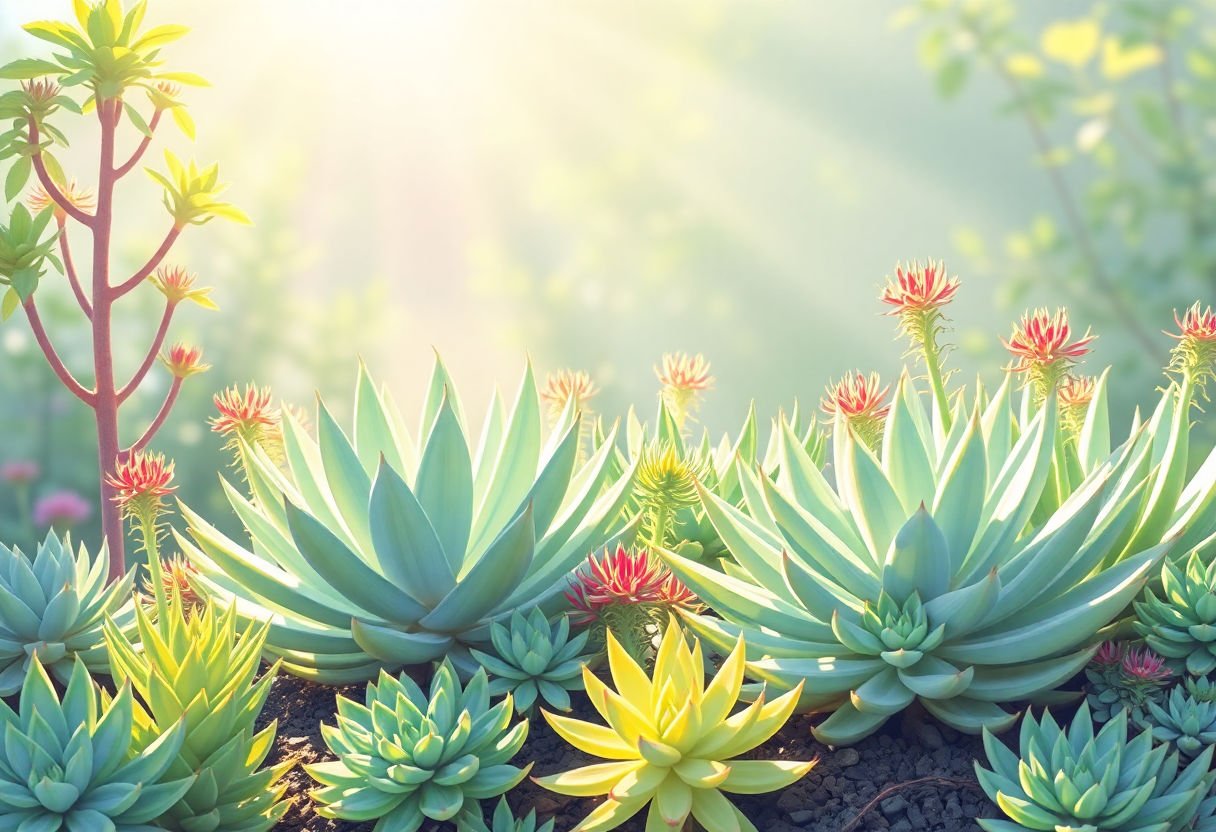Succulents offer a unique charm to any home or garden. These hardy plants, known for their thick, water-storing leaves, need the right amount of sunlight to thrive. Sunlight acts like a meal for succulents. Too much sun, and they might get sunburned. Too little, and they may stretch and lose color. Different succulents crave different amounts and types of light. This guide dives into how much sunlight these plants need, what stress looks like, and how to use artificial light if necessary. With the right care, your succulents will stay healthy and vibrant year-round.
Key Takeaways
- Succulents need both direct and indirect sunlight for healthy growth, depending on the type.
- Too much sun can cause sunburn, while too little leads to stretching and dull colors.
- Indoor succulents need bright spots, near windows or under grow lights.
- Seasonal changes require adjustments in sunlight exposure and care routines.
Understanding Succulent Sunlight Needs
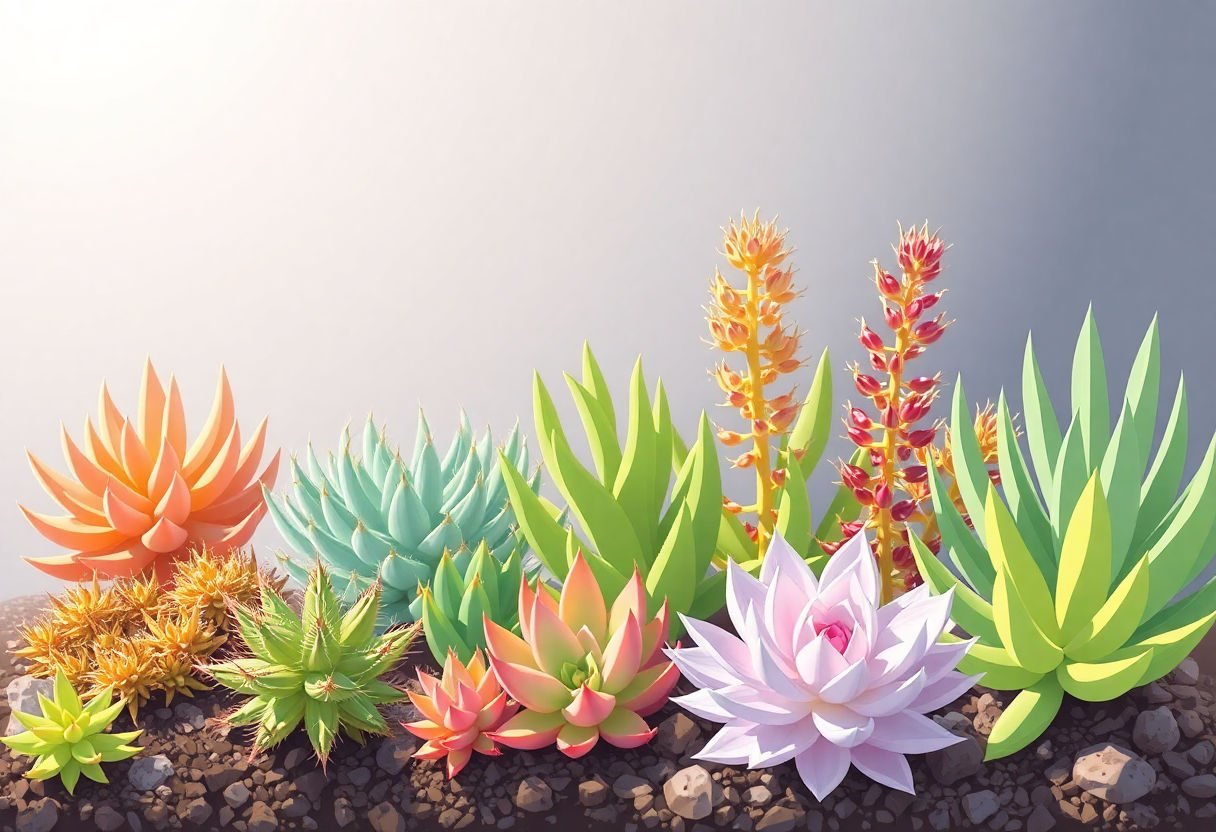
Succulents need sunlight to stay healthy. But not all succulents enjoy the same amount of sunlight. Think of it like people enjoying different seasons. Some might love the bright sun of summer, while others prefer the soft glow of spring.
Echeverias and Sempervivums thrive in full sunlight. They love at least six hours of direct light. Full sunlight gives them their bright colors and healthy growth. Without enough sunlight, these plants can start to stretch. Their leaves might also lose some color.
Haworthias and Gasterias enjoy filtered light. They prefer sunlight that comes through a curtain or blinds. Just like when you wear sunglasses on a sunny day. Direct sunlight can burn their leaves. In shaded spots, they keep their rich green color.
If you have a Jade Plant, find a spot with morning sun and afternoon shade. Too much sun can cause red edges on the leaves. A little shade helps keep their leaves smooth and full.
When giving light to succulents, you can:
- Use south-facing windows for sun-loving plants.
- Place sheer curtains to filter light for those needing softer rays.
- Move pots around every few weeks to adjust sunlight exposure.
Every succulent is unique. Pay attention to leaf color and growth. These cues tell you what your plant needs. Try different spots in your home to find the light they enjoy most.
How Much Sunlight Do Succulents Need?

Succulents thrive on sunlight. It is their energy source. But how much do they actually need? Most succulents bask happily in 6 hours of bright light each day. This amount keeps them vibrant and strong.
Imagine the sun as a meal for succulents. Just like people, they need the right balance. Too little sun leaves them hungry. Too much burns them. Morning sunlight proves best. It gives warmth but not the harshness of midday rays.
Put your succulents in a spot with full exposure. Near a south or east-facing window works well. You can also place them outdoors in a bright but sheltered area. Just make sure intense noon sun does not scorch them.
Monitor them closely. Signs of not enough sunlight? They become tall and lean. The vibrant colors fade, hinting at their struggle. Meanwhile, too much sunlight might result in burnt or brown leaves. Adjust their position if you spot these signs.
Use a simple checklist:
- Minimum 6 hours of bright light
- Morning sun preferred
- South or east-facing windows indoors
- Shade from harsh midday heat
Consistent light keeps succulents healthy. Enjoy these resilient plants as they brighten any space, thriving under their perfect dose of sunlight.
The Best Types of Light for Succulents
Succulents love different types of light. Picking the right light helps them grow well. Let’s look at the three main types of light that succulents enjoy.
Direct Sunlight
Succulents often thrive in direct sunlight. This means the sun’s rays hit the plant without anything blocking them. Think about those sunny spots where the sun beats down all day. Perfect for sun-loving succulents like cacti. They soak up the sun and grow strong. If your succulent lives in a very hot place, it might need a break from the midday sun. You don’t want to burn your leaves.
Indirect Sunlight
Some succulents prefer indirect sunlight. This means the sun isn’t hitting the plant straight on. Maybe there’s a thin curtain or the plant sits in a bright room but away from the window. This kind of light feels softer and spreads around more. Many indoor succulents love this kind of light. It keeps them from getting too hot or too dry.
Filtered Light
Filtered light blends direct and indirect sunlight. Sometimes plants enjoy this through sheer curtains or when a tree provides partial shade. Think of it like the tree offering a bit of comfort, shielding the plant from full sun impacts while still letting light through.
Quick Tips:
- Rotate your succulents to give them uniform sunlight exposure.
- Watch for stretching; this means your succulent seeks more light.
- Use sheer curtains for sunlight control if needed.
Paying attention to your succulent’s light needs helps them stay healthy and vibrant. Keep an eye on their color, size, and shape to know if they are happy with the light they receive.
Identifying Sunlight Stress in Succulents
When succulents face sunlight stress, they show signs. These signs help in understanding their needs. Too much sunlight can cause sunburn. You might see brown or white patches on the leaves. These patches look like scars. It’s a clear sign the plant is getting more sun than it can handle.
On the other side, not enough sunlight changes the plant too. The succulent might stretch. This happens when it reaches out for more light. Its leaves spread out and the stem becomes longer. This is called “etiolation”. It means the plant tries to get closer to light sources.
Some succulents lose their color when stressed. Normally bright leaves turn pale or yellowish. It’s like when humans get stressed and their faces turn pale.
To fix these issues, rearrange their positions. If sunburn occurs, move them to a less sunny spot. If the succulent stretches, place it in a brighter area. Morning sun is often softer and preferred.
Regularly check the leaves. The texture and color tell a story. Healthy leaves feel firm and lively. Pay close attention. This way, you can keep your succulents thriving, just by reading their clues. A bit of care goes a long way.
Indoor vs. Outdoor Sunlight Considerations
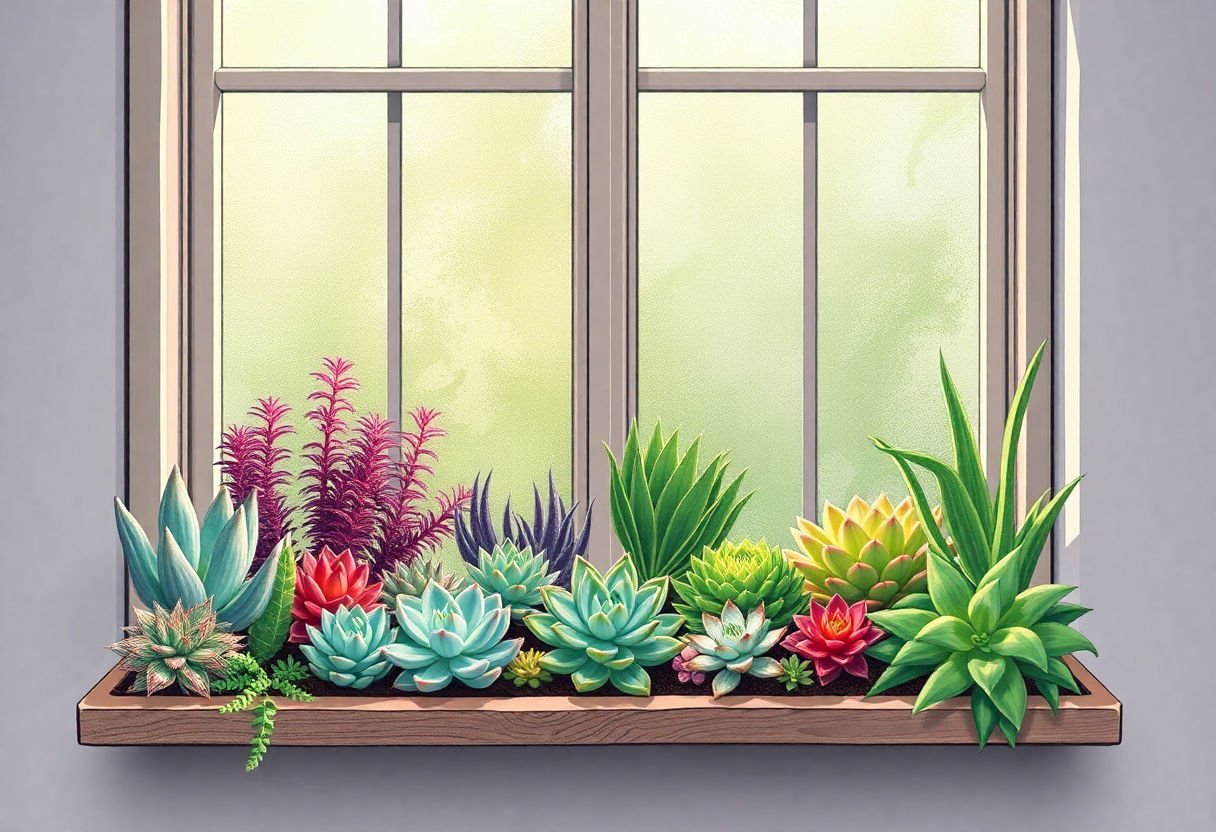
Indoor and outdoor environments affect succulent sunlight needs differently. When people place succulents indoors, they must think about window direction and light quality. South-facing windows give the brightest light. This light is great for succulents. North-facing windows may not provide enough light, leading to stretching and weak growth. East and west-facing windows offer moderate light.
Consider some indoor lighting tips:
- Rotate succulents so all sides receive light.
- Use sheer curtains to filter bright sunlight near large windows.
- Supplement with grow lights during gloomy days or low-light seasons.
For outdoor succulents, direct sunlight can help plants thrive. Still, too much sun can scorch leaves. Outdoor plants enjoy the fresh air and steady exposure to natural light. In hot climates, some shade during peak sun can prevent damage.
Keep these outdoor tips in mind:
- Monitor plants for signs of too much sun, like sunburned patches.
- Move pots to shaded areas if needed.
- Use temporary shade covers during intense heat.
Each setting has unique light conditions. Indoor succulents might need light adjustments, while outdoor ones may require some shelter from harsh sunlight. Providing balanced light lets succulents grow strong and lush in both settings. Observing light patterns helps find what works best for your plants.
Seasonal Sunlight Variations and Succulents
As the year rolls by, sunlight changes. Days get longer or shorter. This affects how much light succulents get. In summer, days feel long. The sun shines brightly. Succulents can soak up lots of sunlight. This helps them grow well. But too much sun might burn them. Sometimes, they might need a little shade.
Winter changes things. Days become short. Sunlight becomes scarce. Many succulents can rest during this time. It’s like a nap. They won’t need as much water or attention. But light matters too. You might need to move them to a sunny window.
Let’s look at some tips:
-
Summer Care: If the sunlight feels too hot, provide shade. Use a thin curtain or move them slightly.
-
Winter Care: Move succulents closer to windows. Choose south or west-facing spots for more light.
-
Watch for Signs: If a succulent stretches toward light, it craves more. Pale leaves might mean too much. Adjust the location based on these signs.
These simple changes help succulents stay healthy through different seasons. They become strong, and pretty. Regular checks can give clues for what they need. Adapting care for the time of year ensures they thrive. It can be as easy as changing a spot, or providing a small shade. The little shifts make a big difference.
Tips for Providing the Right Sunlight
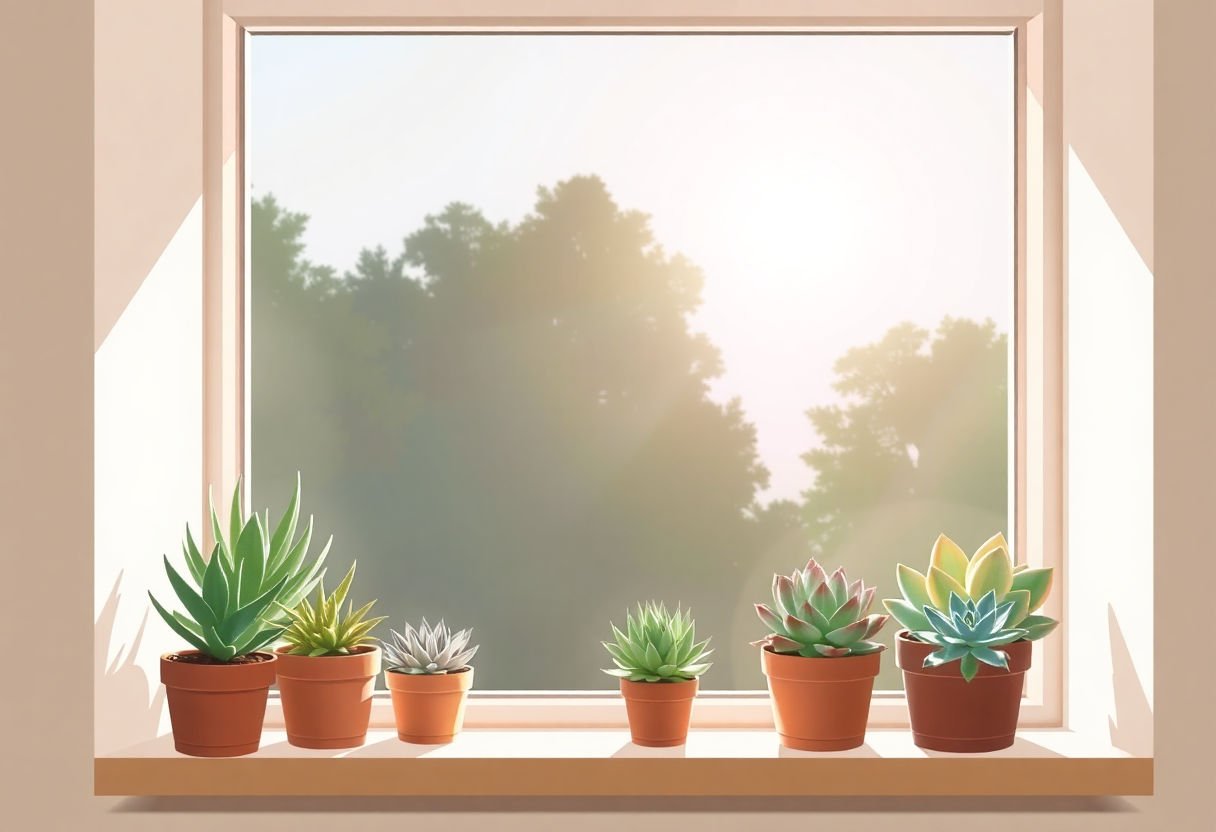
Providing succulents with the right sunlight is like finding the perfect spot to relax on a sunny day. You want just the right amount. Not too much like a desert sun. Not too little like a cloudy afternoon.
Understand your succulent’s needs. Most succulents need bright light, but the intensity can vary. Some thrive in direct sunlight, while others prefer indirect light. Research your specific succulent to know what it needs.
Observe how sunlight moves. Track which areas in your home have the most sunlight during the day. East and west-facing windows usually offer good light. Move your succulents to match their light needs.
Use sheer curtains. If direct sunlight is too harsh, like in summer, sheer curtains can soften it. This creates a gentle, filtered light. Think of it as wearing sunglasses on a bright day.
- Watch for signs of stress:
- Brown or spotty leaves: Too much sun.
- Stretched growth: Not enough sun.
Rotate your succulents. Sometimes, one side gets more light. Rotating every couple of weeks helps them grow evenly.
If natural light is scarce, try artificial lights. Grow lights can supplement sunlight, especially in winter. Look for lights labeled for full-spectrum as they mimic natural sunlight.
Caring for succulents feels like getting their sunbathing just right. Adjust these tips based on the seasons and their response. Always tailor your approach to your plant’s needs.
The Role of Artificial Lighting for Succulents
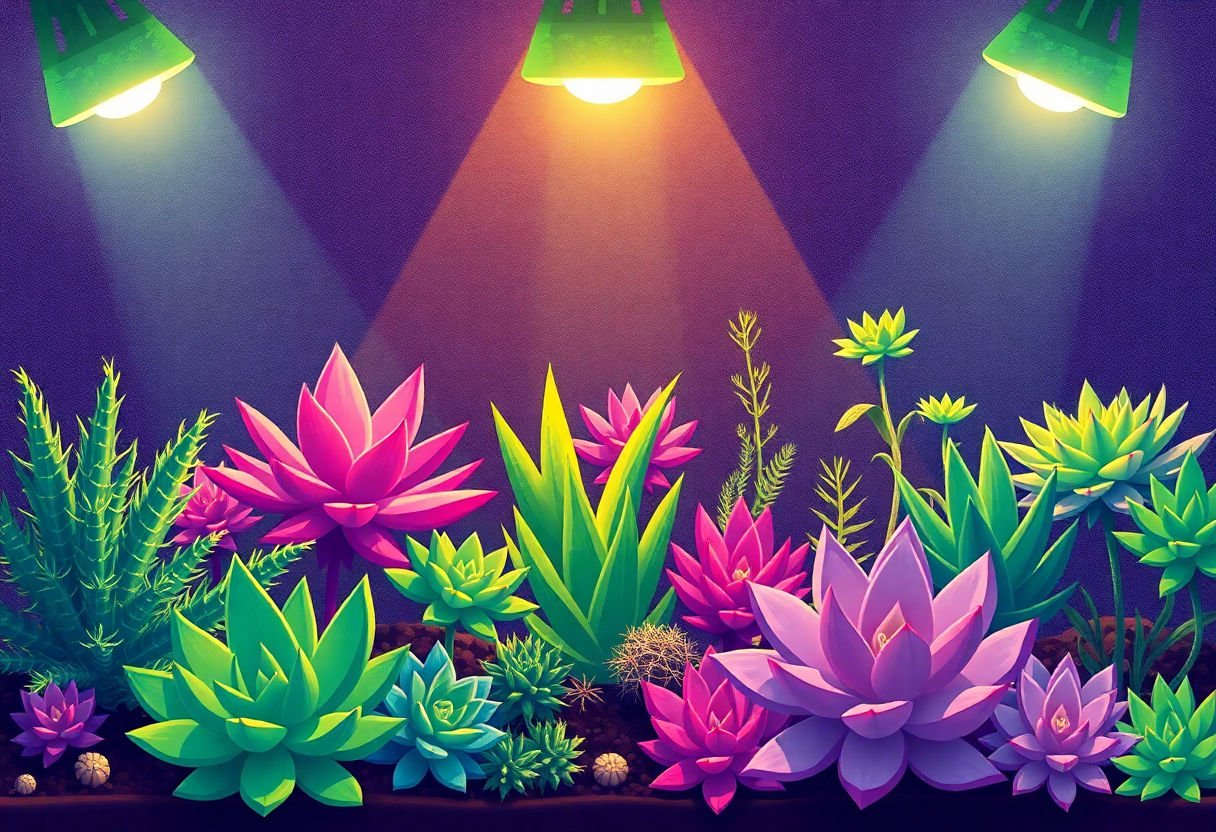
Succulents, like all plants, need light. But, not every home or space offers the same amount of sunlight. Here is where artificial lighting helps. Think of artificial light as a stand-in for the sun. When natural light falls short, artificial light picks up the slack.
Different Types of Lights:
- Fluorescent Lights: These lights work well for most succulents. They provide the required brightness without producing too much heat.
- LED Grow Lights: These are energy-efficient and customizable. They come in different colors, like red and blue, which promote healthy growth.
How to Use Artificial Lights:
- Position: Place the lights about 6 to 12 inches above the succulents. This position mimics the overhead sunlight.
- Duration: Keep the lights on for 12 to 14 hours a day. This imitates a full day of sunlight.
Importance of Light Color:
- Blue Light: Encourages strong leaves.
- Red Light: Promotes flowering if your succulent blooms.
Artificial lights keep succulents healthy when natural light isn’t enough. They don’t replace the sun but fill in the gaps. With the right setup, succulents stay vibrant and strong throughout the year. Always monitor your plants and adjust the light as needed.
Conclusion
Succulents need the right balance of sunlight for vibrant growth. Too much sun can stress them. Too little can stunt them. Adjusting light based on seasons helps maintain their health. Use artificial lights if sunshine is scarce. Watch for signs of stress, like browning leaves or stretching. Remember, each succulent is unique. Observing and tweaking their light exposure leads to healthy plants. Have patience and care, and your succulents will thrive.
Frequently Asked Questions
How much sunlight do succulents need each day?
Succulents thrive with five to six hours of sunlight. But young or sensitive plants might need gentle, filtered light to start with. Morning light usually works best.
Can succulents get too much sun?
Yes, they can get sunburned, just like people. Leaves might turn brown or white. Move them to a shadier spot if this happens.
Are there succulents that can grow indoors?
Many succulents do well indoors near a bright window. Jade and aloe are good examples. They love the light coming through windows.
How do I know if my succulent needs more sunlight?
If your plant stretches or its color fades, it might need more light. This is a sign it is reaching for more sun.
What is the best way to use grow lights for succulents?
Place grow lights about a foot above the plants. Use them 12-16 hours a day, matching the plants’ needs. Rotate plants for even light coverage.
